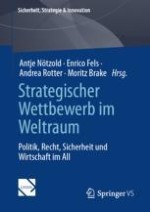2024 | OriginalPaper | Buchkapitel
Aktive Beseitigung von Weltraumschrott zur Aufrechterhaltung und Weiterentwicklung des Ökosystems Weltraum
verfasst von : Alin Olimpiu Albu-Schäffer, Thomas Dekorsy, Gerhard Grunwald, Wolfgang Riede, Stefan Scharring, Máximo A. Roa
Erschienen in: Strategischer Wettbewerb im Weltraum
Verlag: Springer Fachmedien Wiesbaden
Aktivieren Sie unsere intelligente Suche, um passende Fachinhalte oder Patente zu finden.
Wählen Sie Textabschnitte aus um mit Künstlicher Intelligenz passenden Patente zu finden. powered by
Markieren Sie Textabschnitte, um KI-gestützt weitere passende Inhalte zu finden. powered by
